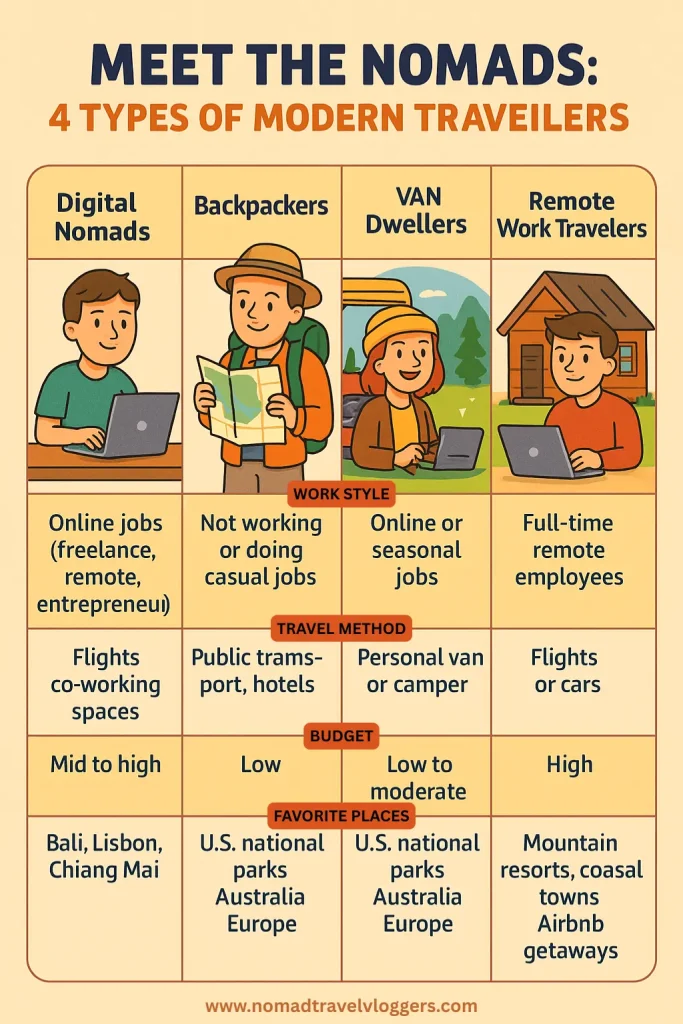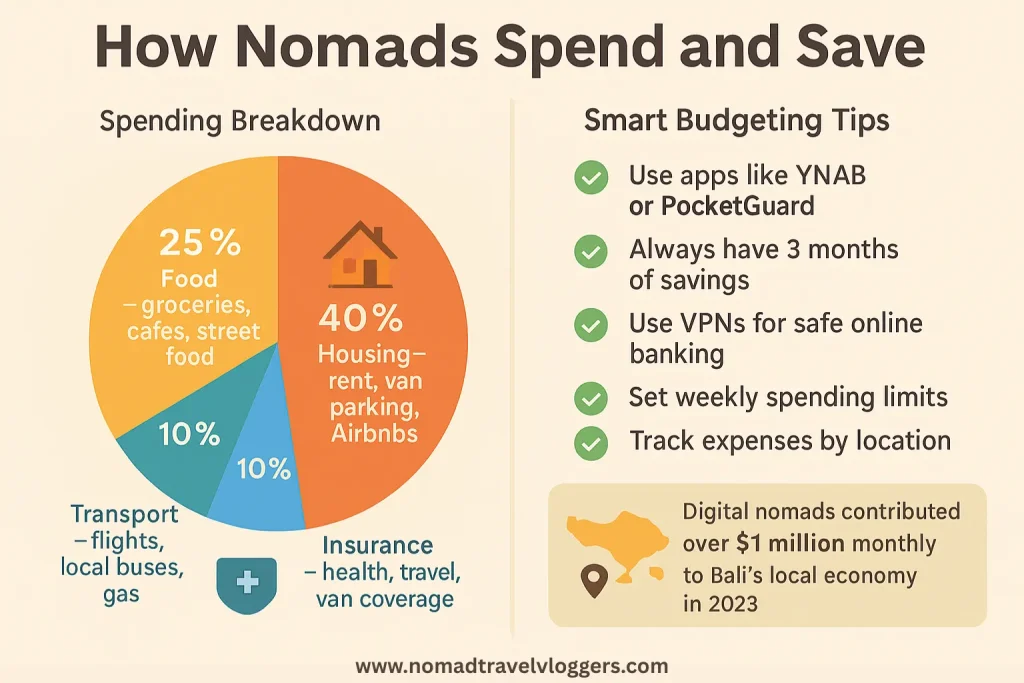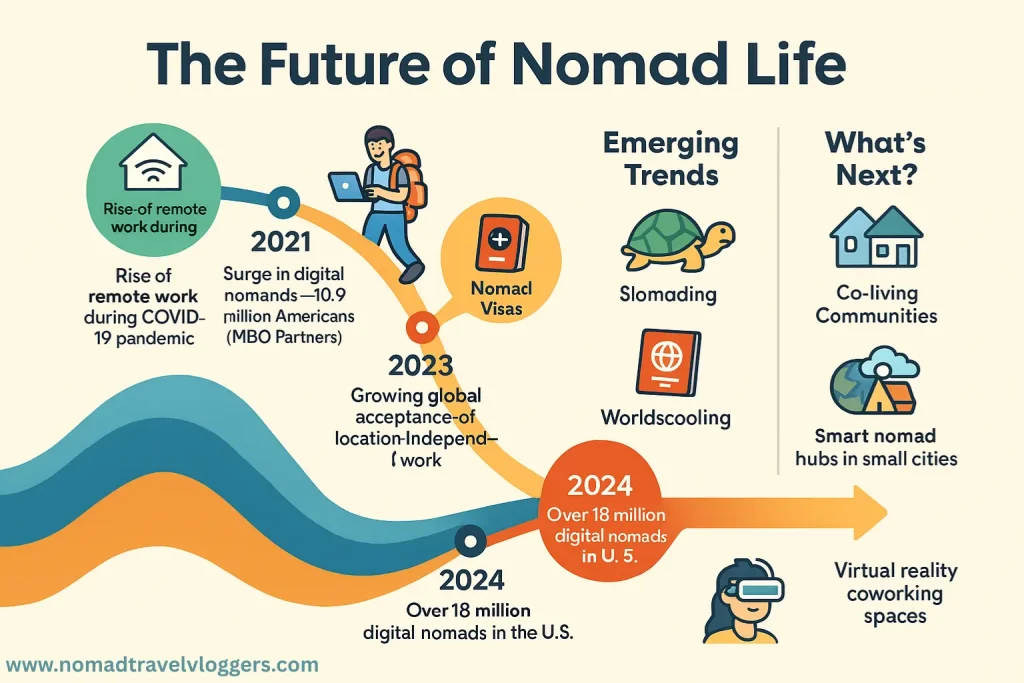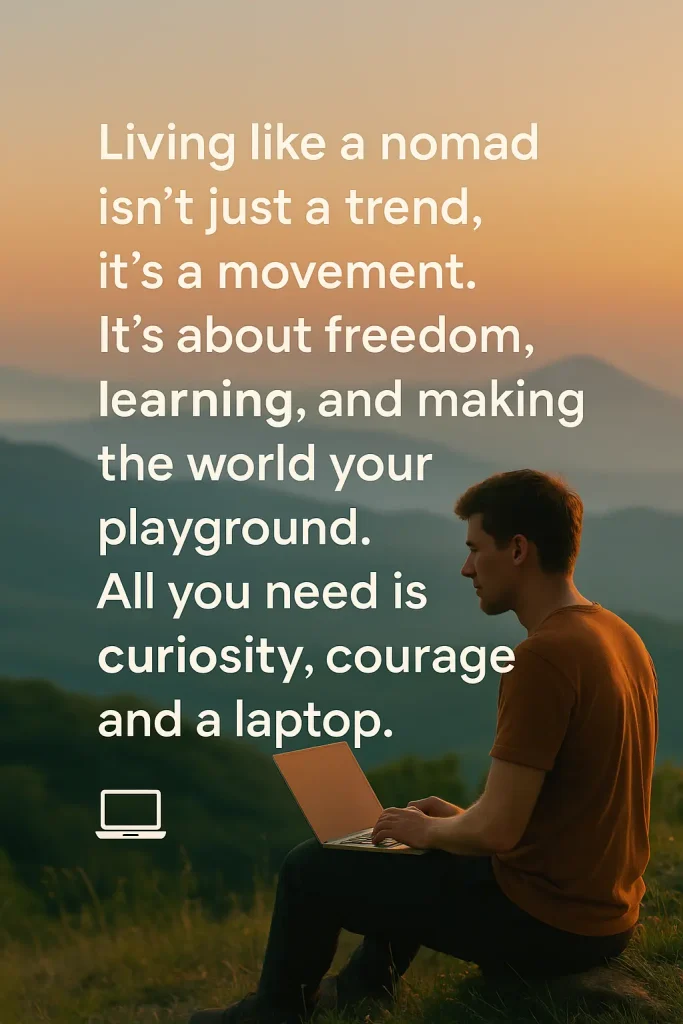The Nomad Lifestyle Explained: Work, Travel, and Live Anywhere
Imagine living in a van, working from a beach, or going to school while traveling the world,this is the exciting life of a modern nomad.

Modern Nomad Lifestyle Types Explained: Which One Are You?
Imagine waking up in a new country every few weeks. One month you’re in the snowy mountains of Canada, and the next you’re sipping coconut water on a beach in Bali. That’s the life of a modern nomad!
In the past, nomads were people who moved from place to place with their animals, looking for food or better weather. But today, nomads aren’t chasing cows, they’re chasing Wi-Fi!
Modern nomads are people who don’t live in one fixed home. Instead, they travel a lot while working from laptops, living in vans, or carrying their backpacks around the world. Their homes can be anywhere: a cabin, a camper van, a hostel, or even a co-working café.
And no, they’re not on vacation all the time. Many of them are working full-time while exploring new places. How cool is that?
This way of life is growing super fast. It’s changing how people think about jobs, homes, and even happiness. Instead of chasing money or fame, nomads often chase experiences and memories.
Meet the Nomads: The 4 Types of Modern Travelers
There are different “tribes” in this nomadic world. Each one lives and travels in their own special way. Let’s meet them!

A visual comparison of modern nomad types, highlighting how each group travels, works, budgets, and where they love to go.A) Digital Nomads
These people work online using laptops and the internet. They can be writers, designers, programmers, teachers, and more. As long as they have Wi-Fi, they can work from anywhere!
Sub-types include:
- Freelancers: They take short-term jobs for different clients.
- Remote workers: They work full-time for one company but from anywhere.
- Entrepreneurs: They own online businesses.
Digital nomads love to work in co-working spaces or cozy cafes. They travel slow, often spending a month or more in one place. They value flexibility and freedom. According to a 2024 study in Tourism Management, digital nomadism is becoming a widely accepted professional lifestyle that balances work and travel.
B) Backpackers
Backpackers travel light. They carry everything in a backpack and stay in budget places like hostels. Most are young adults who love to explore different cultures and make friends from all over the world.
They often avoid touristy spots and look for real, local experiences. Some backpack for a few weeks, others travel for years!
Flashpackers are like backpackers but with more money. They carry fancy gadgets, stay in nicer places, but still seek adventure.
Backpacking is not new. It has been popular since the 1970s. But today, social media and digital maps make it easier than ever.
C) Van Dwellers
Imagine living in a tiny house on wheels. That’s the life of a van dweller! They build beds, kitchens, and storage inside vans and travel across countries.
They love freedom, nature, and saving money. Many van lifers also work online, just like digital nomads.
Vanlife is also about community. There are meetups and online groups where people share tips, routes, and cool camping spots. A 2024 research paper published in the Anthropological Journal of European Cultures explored how van dwellers rely on each other for support, especially during tough times like the COVID-19 pandemic.
D) Remote Work Travelers
These are regular workers who travel occasionally while keeping up with their jobs. Maybe they’ll work from a mountain cabin for a week or a beach resort for two.
They aren’t full-time nomads, but they enjoy mixing work and travel. It helps them feel refreshed and inspired. Studies show that remote work travelers often feel more productive and happy because of their temporary change in environment.
Why Do People Choose This Life?
People become nomads for many reasons. It’s not just about travel. It’s about how they want to live.

This infographic illustrates the main motivations behind choosing the nomad lifestyle, such as flexibility, travel passion, cost savings, and tech access.A) Freedom and Flexibility
Nomads choose their schedules. Want to work early and surf later? Go ahead. Want to work from a treehouse? Why not!
This freedom makes people happier. They can work at their best times, take breaks in nature, and say goodbye to long commutes.
According to research from the University of Twente, the desire for flexibility is a major driver for digital nomads.
B) Escape the 9-to-5
Some feel stuck in normal jobs. Offices can be boring or stressful. Nomads escape that by choosing where and how they work.
They break free from traffic, strict dress codes, and cubicles. Instead, they find joy in creating their own path.
Many even call it a “rebellion” against the old way of life.
C) Love of Travel
Many nomads are explorers at heart. They want to see mountains, oceans, jungles, and cities. They love meeting new people and trying new foods.
Travel gives them stories, lessons, and unforgettable memories.
D) Save Money
Living in a van or a cheap country can save a lot of money. Some nomads earn dollars and spend in places where costs are lower. That means they can live better for less.
This smart trick is called geo-arbitrage. A 2023 study showed that nomads using geo-arbitrage can double their savings while living better.
E) Technology Makes It Possible
Thanks to fast Wi-Fi, Zoom, and laptops, people can now work from almost anywhere. The digital age turned dreams into reality.
From cloud storage to global payment apps, tech is the real MVP of nomad life.
Nomads and Their Communities: Not Alone on the Road
Nomads don’t have to be lonely. They build strong friendships and support systems.
A) Online Friend Groups
Websites and apps like Nomad List or Facebook groups help nomads find each other. They share:
- Travel tips
- Job leads
- Safety info
- Meetups and events
Many digital nomads feel less isolated because of these virtual communities. Researchers call these “digital tribes.”
B) Real-Life Gatherings
Cities like Bali, Chiang Mai, and Lisbon are popular for nomads. They have:
- Co-working spaces
- Shared homes
- Community picnics
Here, nomads work together, share meals, and form lifelong friendships.
Some even create pop-up coworking hubs where they rent houses and work as a team.
C) Helping or Hurting Locals?
Nomads bring money to local cafes and shops. That’s good!
But too many nomads can raise rent prices. Some locals may struggle to afford homes. Cities need to plan wisely to protect everyone.
This is called the “gentrification effect,” and cities like Lisbon and Canggu are already feeling it.
Money Talks: How Nomads Spend and Save
Nomads may not have a fixed address, but they sure know how to handle their money! Whether it’s budgeting for cool places to stay, finding tasty street food, or saving for their next big trip, nomads make every dollar count.

A helpful breakdown of how modern nomads manage money, spending, saving, and contributing to local economies.A) Boosting Local Economies
Nomads spend on:
- Housing
- Food
- Fun activities
- Local transport
This helps businesses grow and creates jobs. In Bali, nomads contribute millions of dollars to the local economy every year.
B) Rising Rent and Internet Strain
More travelers can mean higher rents. That can push locals out.
Also, more people means more pressure on things like water, electricity, and the internet.
Governments are now considering “digital nomad impact fees” to support infrastructure.
C) Managing Their Own Money
Nomads must be good at:
- Budgeting
- Saving
- Planning for emergencies
They also buy travel insurance and pay for global phone plans. Smart money habits help them stay happy on the road.
Here’s a quick tip list for financial safety:
- Use cloud-based budget apps (like YNAB or PocketGuard)
- Always have 3 months’ expenses saved
- Use VPNs for online banking security
How Nomad Lifestyle Affects Mental Health
Living a life full of travel sounds like a dream, but even dreams come with ups and downs. While many nomads feel happier, more confident, and free, others sometimes feel lonely or worn out from always being on the move.

This visual shows how the nomad lifestyle impacts mental health—highlighting both its benefits and challenges.Let’s check out what this kind of life can do to your mood, both the awesome stuff and the tricky parts.
A) Good for the Mind
- Nature lowers stress (Stanford study 2015)
- Traveling builds confidence
- Freedom improves self-esteem
- Exploring fights boredom
B) The Tough Stuff
- Loneliness happens
- Always moving can be tiring
- Hard to make long-term friends
- Unstable income causes stress
Some nomads face “post-travel blues,” which is like feeling sad after an adventure ends.
C) Staying Productive on the Go
Some nomads stay focused. Others get distracted.
They learn to:
- Plan daily schedules
- Choose good work spots
- Take healthy breaks
Researchers say nomads need high self-discipline to succeed. Having a daily routine helps keep balance.
Culture Shock and Identity: Learning and Growing
When you travel a lot, the world becomes your teacher. Nomads don’t just visit new places, they dive into them!
They taste new foods, try new words, and join in local traditions. And while they explore outside, they also discover more about themselves. In this part, we’ll see how life on the road can shape who you are, what you believe, and even how you talk!
Let’s see how all this adventure can make you see the world, and yourself, a little differently.
A) Learning from the World
Nomads see:
- New languages
- Different foods
- Unique traditions
They become more kind, curious, and open-minded.
Some even learn to cook local dishes or celebrate new holidays.
B) Finding Yourself on the Road
Travel teaches:
- What really matters
- How to adapt
- How to be brave
Nomads often say, “I found myself by getting lost.”
Their identity changes. They value people and moments more than things.
C) Building Nomad Culture
Nomads share:
- Tips
- Stories
- Beliefs about freedom, simplicity, and adventure
They even create their own slang, like “slomad” (slow nomad) and “bleisure” (business + leisure).
The Future of Nomad Life
The nomad lifestyle isn’t slowing down, it’s just getting started! More people of all ages are packing their bags, grabbing their laptops, and hitting the road.
Some take it slow, others travel with their kids, and many are finding brand-new ways to live and learn.

A visual timeline and trend map of the nomad lifestyle, from its rise in 2020 to emerging movements like slomading and world schooling.Let’s peek into what the future might look like for this adventure-filled way of life.
A) It’s Growing Fast
In 2024, over 18 million Americans became digital nomads. More companies now support remote work.
Nomadism is moving from “trend” to “mainstream.”
B) Not Just for Young Folks
Even people over 55 are joining. Families are home-schooling kids while traveling.
More parents are creating “world schooling” plans that mix travel and education.
C) New Trends
- Slomading: Travel slower, stay longer
- Staycations: Explore your home country
- Nomad Visas: Countries like Portugal invite nomads
There’s even a global contest now: Who can attract more digital nomads to help grow local economies?
What the Scientists Say
Guess what? Even scientists are curious about the nomad lifestyle! They’ve been studying people who live and work on the go to figure out why they do it, how it changes their work life, and what it means for the places they visit.
Here’s some cool stuff they’ve found:
Why People Choose This Life
A study by Hannonen (2020) shows that most nomads are in it for the freedom, the chance to travel, and smart money moves like geo-arbitrage, earning in one country and spending in a cheaper one.
🔗 See the study on ResearchGate
How It Changes Work
In 2023, researchers looked at Instagram posts to study how people feel during remote work trips. Turns out, working while traveling often makes people happier and more motivated.
🔗 Read the paper
Another study found that trying out nomad-style work helps people learn about themselves and improve their work habits, sometimes even after they go back home.
🔗 Check it out
What It Means for Local Places
Nomads don’t just change their own lives, they also make an impact on the cities and towns they visit. One review looked at places like Lisbon and found that nomads can help local businesses grow but might also cause higher rent prices.
🔗 Explore the review
Mental Health Boosts (and Some Bumps)
Traveling while working can be really good for your mental health, like giving your brain a fresh breeze. But living on the move for too long can also get lonely or stressful if you don’t have support.
🔗 Read the full study
The Nomad Adventure Is Just Getting Started
Nomad traveling isn’t just about going places. It’s about changing how we live, work, and see the world.
It teaches us:
- That home can be anywhere
- That experiences matter more than things
- That we can be our best selves when we explore
Whether you dream of being a digital nomad, a backpacker, or just taking a remote trip once in a while, the world is open to explore. And your journey can start anytime.



